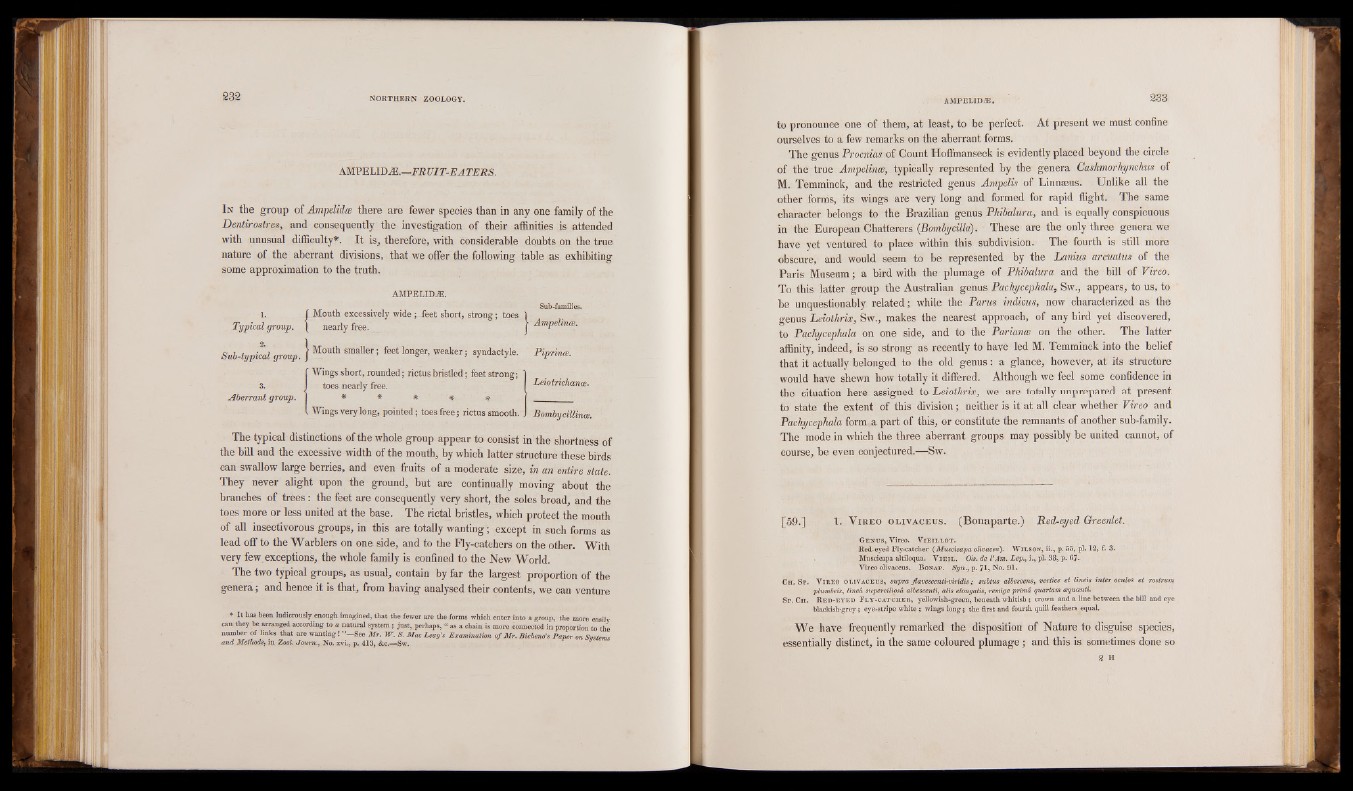
A U m U D JE .—FRUIT-EATERS.
In the group of Ampelidw there are fewer species than in any one family of the
Dentirostres, and consequently the investigation of their affinities is attended
with unusual difficulty*. It is, therefore, with considerable doubts on the true
nature of the aberrant divisions, that we offer the following table as exhibiting
some approximation to the truth.
AMPELIDW.
l. fMouth excessively wide; feet short, strong; toes \ Sub-families.
Typical group. \ nearly free. j
Sub-typkal group. } M°Uth smaller; feet lonSer> weaker 5 syndaqtyle, Piprinee.
f Wings short, rounded; rictus bristled; feet strong; ]
3. I toes nearly free. ~ I Lklolrichana'..
Aberrant group. 1 * * * * * f ________
l Wings very long, pointed; toes free; rictus smooth. J Bambydllintt.
The typical distinctions of the whole group appear to consist in the shortness of
the bill and the excessive width of the mouth, by which latter structure these birds
can swallow large berries, and even fruits of a moderate size, in an entire state. They never alight upon the ground, but are continually moving about the
branches of trees: the feet are consequently very short, the soles broad, and the
toes more or less united at the base. The rictal bristles, which protect the mouth
of all insectivorous groups, in this are totally wanting; except in such forms as
lead off to the Warblers on one side, and to the Fly-catchers on the other. With
very few. exceptions, the whole family is confined to the New World.
The two typical groups, as usual, contain by far the largest proportion of the
genera; and hence it is that, from having analysed their contents, we can venture
* — ^as been ludicrously enough imagined, that the fewer are the forms which enter into a group, the more easily
can they be arranged according to a natural system; just, perhaps, “ as a chain is more connected in proportion to the
number of links that are wanting! ”—See Mr. W. S. Mac Leay's Examination of Mr. Bicheno’s Paper on Systems
and.Methods, in Zool. Journ., No. xvi., p. 413, &c.—-Sw.
to pronounce one of them, at least, to be perfect. At present we must confine
ourselves to a few remarks on the aberrant forms.
The genus Procnias of Count Hoffmanseck is evidently placed beyond the circle
of the true Ampelince, typically represented by the genera Cashmorhynchus of
M. Temminck, and the restricted genus Ampelis of Linnaeus. Unlike all the
other forms, its wings are very long and formed for rapid flight. The same
character belongs to the Brazilian genus Phibalura, and is equally conspicuous
in the European Chatterers (Bomby cilia). These are the only three genera we
have yet ventured to place within this subdivision. The fourth is still more
obscure, and would seem to be represented by the Lanius arcuatus of the
Paris Museum; a bird with the plumage of Phibalura and the bill of Vireo.
To this latter group the Australian genus Pachycephala, Sw., appears, to us, to
be unquestionably relatedwhile the Parus indicus, now characterized as the
genus Leiothrix, Sw., makes the nearest approach, of any bird yet discovered,
to Pachycephala on one side, and to the Parlance on the other. The latter
affinity, indeed, is so strong as recently to have led M. Temminck into the belief
that it actually belonged to the old genus: a glance, however, at its structure
would have shewn how totally it differed. Although we feel some confidence in
the situation here assigned to Leiothrix, we are totally unprepared at present
to state the extent of this division; neither is it at all clear whether Vireo and
Pachycephala form a part of this, or constitute the remnants of another sub-family.
The mode in which the three aberrant groups may possibly be united cannot, of
course, be even conjectured.—Sw.
[59.] . 1. V ir e o o l iv a c e b s . (Bonaparte.) Red-eyed Greenlet.
Ge n u s , Vireo. Vi e il l o t . Red-eyed Fly-catcher (Muscicapa olivacea). W ilso n , ii., p. 55, pi. 12, f. 3.
Muscicapa altiloqua. V i e i l . Ois. de VAm. Ley., i., pi. 38, p. 67»
Vireo olivaceus. B onap. Syn., p. 71) No. 91.
Ch . Sp . V ir e o ot.iv a c eu s, supra flavescenti-viridis; subtus albescens, vertiee et lineis inter oculos et rostrum
plvmbeis, lined supercilipsd albescenti, alis elongatis, remige primd quartam cequanti.
Sp. Ch . R e d -e y e d F l y -c a t c h e r , yellowish-green, beneath whitish; crown and a line between the bill and eye
blackish-grey ; eye-stripe white; wings long; the first and fourth quill feathers equal.
We have frequently remarked the disposition of Nature to disguise species,
essentially distinct, in the same coloured plumage; and this is sometimes done so